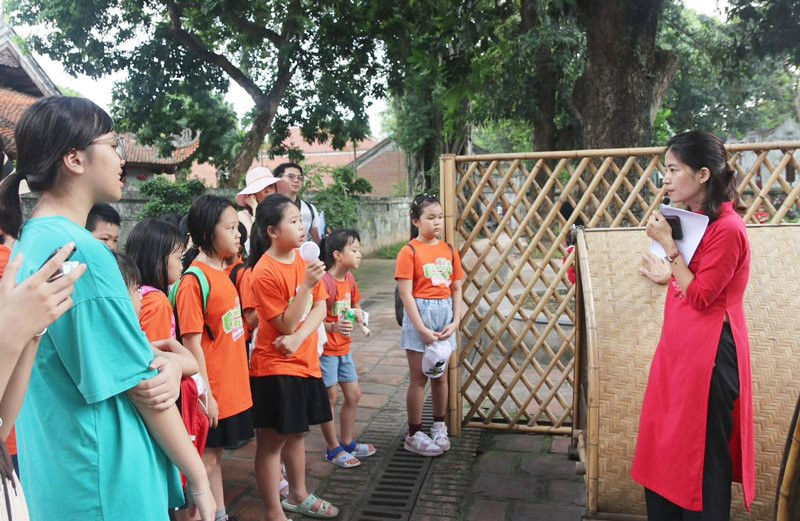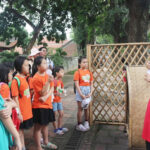Beyond serving as repositories for exceptional historical, cultural, and scientific values, museums and historical sites are utilized as dynamic resources to impart knowledge, foster a love for, and instill pride in the cultural traditions of the nation.
Many cultural destinations have capitalized on this advantage to introduce increasingly novel and captivating forms of experience, nurturing intellect while disseminating the values of heritage in modern life.

Experiential educational activities at the Temple of Literature – Quoc Tu Giam attract the attention and love of many young tourists.
Innovating Heritage Experiences
As a pioneer in diverse heritage experience methods, the Temple of Literature – Quoc Tu Giam offers more than 30 distinct experiential activities, catering to various age groups and the desire to explore the diverse values of the site. For instance, the program “Seeking Mascots on Ancient Structures” is organized as a game through six gates, corresponding to six architectural sections within the heritage site. At each gate, participating teams must identify the mascot and select the correct answer regarding the meaning of that mascot in the shortest time possible to swiftly reach the finish line and secure victory.
According to Master Duong Ngoc Ha (Center for Cultural and Scientific Activities at the Temple of Literature), “The game is designed to create a competitive element in terms of time between the teams, as well as establish a connection between the players and specific cultural elements, namely the mascots, making the heritage experience more intriguing. By participating in the game, players not only need to recognize the mascots and understand their significance but also identify the architectural structures, thereby enhancing the players’ understanding of the heritage.”
Similarly, the Temple of Literature, Quoc Tu Giam, and the Vietnam Military History Museum are actively promoting experiential programs such as the 3D Tour “Hanoi’s 12 Days and Nights of Victory,” “Rice Jar Saves from Famine,” “Liberation Soldier,” “Martyr Soldier,” “Become a Pilot,” “Become a Tank Soldier,” etc., applicable to diverse age groups with a range of interactive activities from online to on-site. This integrated experiential model cleverly aligns the educational content of schools with the museum’s goal of introducing and interpreting heritage.
“To develop these programs, the museum thoroughly studies the high school history curriculum, and designs experiential activities suitable for various age groups, making them engaging for students to grasp knowledge about heritage in a fun and interesting manner,” shared Senior Lieutenant Colonel Le Vu Huy, Director of the Vietnam Military History Museum.
Bringing Museums and Historical Relics Closer to the Public
In keeping with the contemporary and refined approach to heritage accessibility, numerous museums and historical sites in Hanoi are actively exploring and innovating ways to bring heritage closer to the public. For example, the Ho Chi Minh Museum offers online educational programs centered around themes like homeland, family, Uncle Ho’s youth, Uncle Ho’s journey to save the nation, and Uncle Ho with children. Similarly, the National History Museum organizes the “I Love History” club with various enticing themes such as “Following the flow of history,” “Turning puzzle pieces, searching for heritage,” and “Flag drill,” incorporating diverse activities like hosting as an MC, interacting with historical witnesses, and embodying historical figures. The Imperial Citadel of Thang Long introduces a corner for exploring “Young archaeologists,” as well as night tours titled “Decoding the Imperial Citadel of Thang Long.” These fresh programs have contributed to making cultural experiences more appealing, especially to the younger audience.
Nguyen Thi Yen, Head of the Conservation and Exhibition Department (Thang Long – Hanoi Heritage Conservation Center), reveals, “The center is perfecting a 3D film screening room to recreate ancient court stories and rituals. Soon, the center will continue upgrading exploration spaces, and interactions, and integrating experiential activities with regular exhibitions. Special attention will be given to innovating and supplementing some historical topics such as the Tran Nguyen transformation of Thang Long and the astronomical observatory in history. Additionally, environmental education content will be incorporated into heritage education programs under the theme ‘Green heritage – Our heritage,’ contributing to making the cultural experience more enticing.”
Addressing this matter, Vice President of the Cultural Heritage Association of Vietnam, Le Thi Minh Ly, asserts that education through heritage is a distinctive feature of museums and historical sites. In today’s practical conditions, museums and historical sites should focus on three major priorities: “exhibition and interpretation,” transforming information into knowledge and emotions; “interaction,” promoting experiences and information-seeking, encouraging the active participation of visitors; and finally, “digitization” – building databases for interpretation, exhibition, and heritage education – a crucial method for bringing cultural heritage closer to all layers of the public. “At that point, technology under our hands and minds will become a magical wand, skillfully transforming museums and historical sites into countless compelling stories,” emphasizes Ms. Le Thi Minh Ly.
Nguyen Thanh
Đa dạng hình thức trải nghiệm di sản (hanoimoi.vn)

